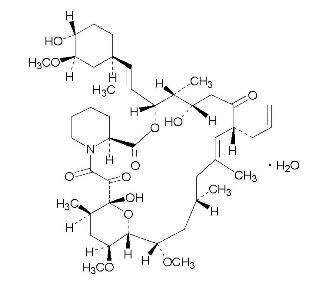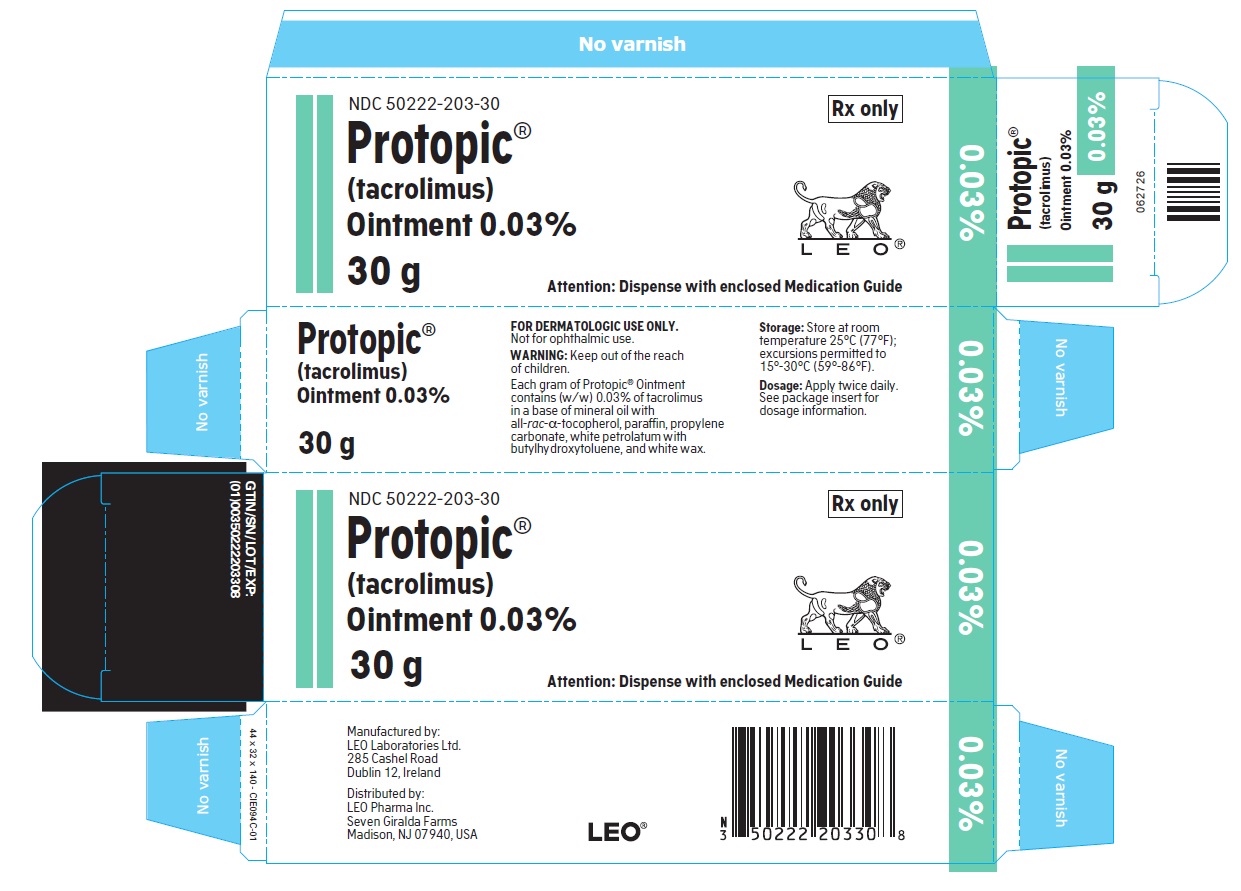Protopic
Generic name: tacrolimus
What is Protopic?
Protopic Ointment is a prescription medicine used on the skin (topical) to treat eczema (atopic dermatitis). Protopic Ointment is in a class of medicines called topical calcineurin inhibitors. It is for adults and children 2 years of age and older who do not have a weakened immune system. Protopic Ointment is used on the skin for short periods, and if needed, treatment may be repeated with breaks in between.
Protopic Ointment is for use after other prescription medicines have not worked for you, or if your doctor recommends that other prescription medicines should not be used.
Description
Protopic (tacrolimus) Ointment contains tacrolimus, a macrolide immunosuppressant produced by Streptomyces tsukubaensis. It is for topical dermatologic use only. Chemically, tacrolimus is designated as [3S-[3R*[E(1S*,3S*,4S*)],4S*,5R*,8S*,9E,12R*,14R*,15S*,16R*,18S*,19S*,26aR*]]-5,6,8,11,12,13,14,15,16,17,18,19,24,25,26,26a-hexadecahydro-5,19-dihydroxy-3-[2-(4-hydroxy-3-methoxycyclohexyl)-1-methylethenyl]-14,16-dimethoxy-4,10, 12,18-tetramethyl-8-(2-propenyl)-15,19-epoxy-3H-pyrido[2,1-c][1,4] oxaazacyclotricosine-1,7,20,21(4H,23H)-tetrone,monohydrate. It has the following structural formula:

Tacrolimus has an empirical formula of C44H69NO12•H2O and a formula weight of 822.03. Each gram of Protopic Ointment contains (w/w) either 0.03% or 0.1% of tacrolimus in a base of mineral oil with all-rac-α-tocopherol, paraffin, propylene carbonate, white petrolatum with butylhydroxytoluene, and white wax.
Mechanism of Action
The mechanism of action of tacrolimus in atopic dermatitis is not known. While the following have been observed, the clinical significance of these observations in atopic dermatitis is not known. It has been demonstrated that tacrolimus inhibits T-lymphocyte activation by first binding to an intracellular protein, FKBP-12. A complex of tacrolimus-FKBP-12, calcium, calmodulin, and calcineurin is then formed and the phosphatase activity of calcineurin is inhibited.
This effect has been shown to prevent the dephosphorylation and translocation of nuclear factor of activated T-cells (NF-AT), a nuclear component thought to initiate gene transcription for the formation of lymphokines (such as interleukin-2, gamma interferon). Tacrolimus also inhibits the transcription for genes which encode IL-3, IL-4, IL-5, GM-CSF, and TNF-α, all of which are involved in the early stages of T-cell activation. Additionally, tacrolimus has been shown to inhibit the release of pre-formed mediators from skin mast cells and basophils, and to down regulate the expression of FcεRI on Langerhans cells.
What is the most important information I should know about Protopic?
The safety of using Protopic Ointment for a long period of time is not known. A very small number of people who have used Protopic Ointment have had cancer (for example, skin or lymphoma). However, a link with Protopic Ointment has not been shown. Because of this concern:
- Do not use Protopic Ointment continuously for a long time.
- Use Protopic Ointment only on areas of your skin that have eczema.
- Do not use Protopic Ointment on a child under 2 years old.
Protopic Ointment comes in two strengths:
- Only Protopic Ointment 0.03% is for use on children aged 2 to 15 years.
- Either Protopic Ointment 0.03% or 0.1% can be used by adults and children 16 years and older.
Talk to your doctor for more information.
Who should not take Protopic?
Protopic Ointment should not be used:
- on children younger than 2 years of age.
- if you are allergic to Protopic Ointment or anything in it. See the end of this Medication Guide for a complete list of ingredients.
What should I tell my healthcare provider before taking Protopic?
Before you start using Protopic Ointment, you and your doctor should talk about all of your medical conditions, including if you:
- have a skin disease called Netherton’s syndrome (a rare inherited condition).
- have any infection on your skin including chicken pox or herpes.
- have been told you have a weakened immune system.
- are pregnant, breastfeeding, or planning to become pregnant.
Tell your doctor about all the medicines you take and skin products you use including prescription and nonprescription medicines, vitamins, and herbal supplements.
Know the medicines you take. Keep a list of them with you to show your doctor and pharmacist each time you get a new medicine.
How should I use Protopic?
- Use Protopic Ointment exactly as prescribed.
- Use Protopic Ointment only on areas of your skin that have eczema.
- Use Protopic Ointment for short periods, and if needed, treatment may be repeated with breaks in between.
- Stop Protopic Ointment when the signs and symptoms of eczema, such as itching, rash, and redness go away, or as directed by your doctor.
- Follow your doctor’s advice if symptoms of eczema return after treatment with Protopic Ointment.
- Call your doctor if:
- your symptoms get worse with Protopic Ointment.
- you get an infection on your skin.
- your symptoms do not improve after 6 weeks of treatment. Sometimes other skin diseases can look like eczema.
To apply Protopic Ointment:
- Wash your hands before applying Protopic Ointment.
- Apply a thin layer of Protopic Ointment twice daily to the areas of skin affected by eczema.
- Use the smallest amount of Protopic Ointment needed to control the signs and symptoms of eczema.
- If you are a caregiver applying Protopic Ointment to a patient, or if you are a patient who is not treating your hands, wash your hands with soap and water after applying Protopic Ointment. This should remove any ointment left on the hands.
- Do not bathe, shower, or swim right after applying Protopic Ointment. This could wash off the ointment.
- You can use moisturizers with Protopic Ointment. Make sure you check with your doctor first about the products that are right for you. Because the skin of patients with eczema can be very dry, it is important to keep up good skin care practices. If you use moisturizers, apply them after Protopic Ointment.
What should I avoid while using Protopic?
- Do not use ultraviolet light therapy, sun lamps, or tanning beds during treatment with Protopic Ointment.
- Limit sun exposure during treatment with Protopic Ointment even when the medicine is not on your skin. If you need to be outdoors after applying Protopic Ointment, wear loose fitting clothing that protects the treated area from the sun. Ask your doctor what other types of protection from the sun you should use.
- Do not cover the skin being treated with bandages, dressings or wraps. You can wear normal clothing.
- Avoid getting Protopic Ointment in the eyes or mouth. Do not swallow Protopic Ointment. If you do, call your doctor.
What are the possible side effects of Protopic?
The most common side effects of Protopic Ointment at the skin application site are stinging, burning, or itching of the skin treated with Protopic Ointment. These side effects are usually mild to moderate, are most common during the first few days of treatment, and usually go away as your skin heals.
Other side effects include acne, swollen or infected hair follicles, headache, increased sensitivity of the skin to hot or cold temperatures, or flu-like symptoms such as the common cold and stuffy nose, skin tingling, upset stomach, muscle pain, swollen glands (enlarged lymph nodes), or skin infections including cold sores, chicken pox or shingles.
Talk to your doctor if you have a skin infection or if side effects (for example, swollen glands) continue or bother you.
While you are using Protopic Ointment, drinking alcohol may cause the skin or face to become flushed or red and feel hot.
These are not all the side effects with Protopic Ointment. Ask your doctor or pharmacist for more information.
Call your doctor for medical advice about side effects. You may report side effects to FDA at: 1-800-FDA-1088.
General information about the safe and effective use of Protopic
Medicines are sometimes prescribed for purposes other than those listed in a Medication Guide. Do not use Protopic Ointment for a condition for which it was not prescribed. Do not give Protopic Ointment to other people, even if they have the same symptoms you have. It may not be right for them.
This Medication Guide summarizes the most important information about Protopic Ointment. If you would like more information, talk with your doctor.
Your doctor or pharmacist can give you information about Protopic Ointment that is written for health care professionals. For more information, you can call: 1-877-494-4536.
Label
Ointment 0.03%
- NDC 50222-203-30
- Rx only
- Protopic® (tacrolimus) Ointment 0.03%
- 30 g
- Attention: Dispense with enclosed Medication Guide

OINTMENT 0.1%
- NDC 50222-211-30
- Rx only
- Protopic® (tacrolimus) Ointment 0.1%
- 30 g
- Attention: Dispense with enclosed Medication Guide

How should I store Protopic?
- Store Protopic Ointment at room temperature (59° to 86°F). Do not leave Protopic Ointment in your car in cold or hot weather. Make sure the cap on the tube is tightly closed.
- Keep Protopic Ointment and all medicines out of the reach of children.
What are the ingredients in Protopic?
Active Ingredient: tacrolimus
Inactive Ingredients: mineral oil, paraffin, propylene carbonate, white petrolatum, white wax, all-rac-α-tocopherol and butylhydroxytoluene.
SRC: NLM .
